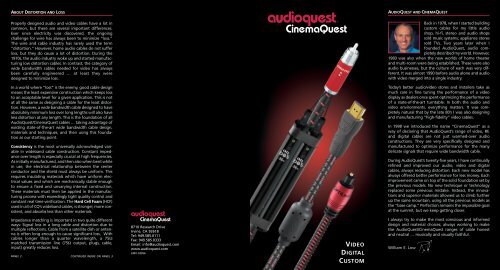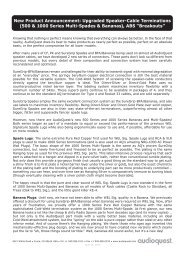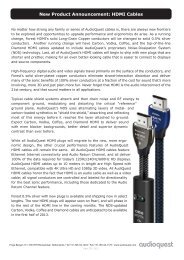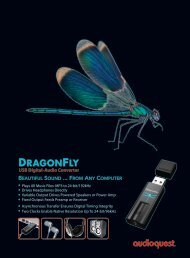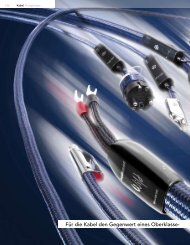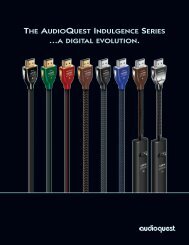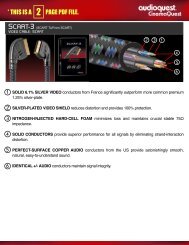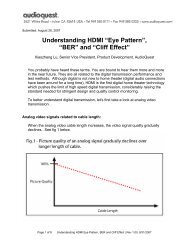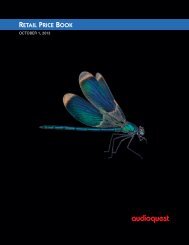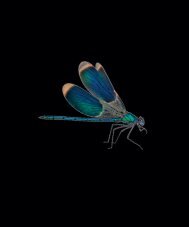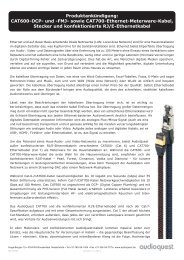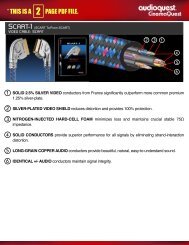04250 CQ Brochure US REV - Audioquest
04250 CQ Brochure US REV - Audioquest
04250 CQ Brochure US REV - Audioquest
Create successful ePaper yourself
Turn your PDF publications into a flip-book with our unique Google optimized e-Paper software.
ABOUT DISTORTION AND LOSS<br />
AUDIOQUEST AND CINEMAQUEST<br />
Properly designed audio and video cables have a lot in<br />
common, but there are several important differences.<br />
Ever since electricity was discovered, the ongoing<br />
challenge for wire has always been to minimize “loss.”<br />
The wire and cable industry has rarely used the term<br />
“distortion.” However, home audio cables do not suffer<br />
loss, but they do cause a lot of distortion. During the<br />
1970s, the audio industry woke up and started manufacturing<br />
low distortion cables. In contrast, the category of<br />
wide bandwidth cables needed for video has always<br />
been carefully engineered … at least they were<br />
designed to minimize loss.<br />
Back in 1978, when I started building<br />
custom cables for my little audio<br />
shop, hi-fi, stereo and audio shops<br />
sold music systems; appliance stores<br />
sold TVs. Two years later when I<br />
founded AudioQuest, audio completely<br />
described my world. However,<br />
1980 was also when the new worlds of home theater<br />
and multi-room were being established. These were also<br />
audio businesses, but the culture of each was very different.<br />
It was almost 1990 before audio alone and audio<br />
with video merged into a single industry.<br />
In a world where “loss” is the enemy, good cable design<br />
means the least expensive construction which keeps loss<br />
to an acceptable level for a given application. This is not<br />
at all the same as designing a cable for the least distortion.<br />
However, a wide bandwidth cable designed to have<br />
absolutely minimum loss over long lengths will also have<br />
less distortion at any length. This is the foundation of all<br />
AudioQuest/CinemaQuest cables … taking advantage of<br />
existing state-of-the-art wide bandwidth cable design,<br />
materials and techniques, and then using this foundation<br />
as our starting point.<br />
Consistency is the most universally acknowledged variable<br />
in wideband cable construction. Constant impedance<br />
over length is especially crucial at high frequencies.<br />
As initially manufactured, and then also when bent while<br />
in use, the electrical relationship between the center<br />
conductor and the shield must always be uniform. This<br />
requires insulating materials which have uniform electrical<br />
values and which are mechanically stable enough<br />
to ensure a fixed and unvarying internal construction.<br />
These materials must then be applied in the manufacturing<br />
process with exceedingly tight quality control and<br />
constant real time verification. The Hard Cell Foam (HCF)<br />
used in all of <strong>CQ</strong>’s wideband cables, is stronger, more consistent,<br />
and absorbs less than other materials.<br />
Today’s better audio/video stores and installers take as<br />
much care in fine tuning the performance of a video<br />
display as dealers once spent optimizing the performance<br />
of a state-of-the-art turntable. In both the audio and<br />
video environments, everything matters. It was completely<br />
natural that by the late 80’s I was also designing<br />
and manufacturing “high-fidelity” video cables.<br />
In 1998 we introduced the name “CinemaQuest” as a<br />
way of declaring that AudioQuest’s range of video, RF,<br />
and digital cables are not just warmed-over audio<br />
constructions. They are very specifically designed and<br />
manufactured to optimize performance for the many<br />
delicate signals that require wide bandwidth cable.<br />
During AudioQuest’s twenty-five years, I have continually<br />
refined and improved our audio, video and digital<br />
cables, always reducing distortion. Each new model has<br />
always offered better performance for less money. Each<br />
improvement came on top of the solid foundation set by<br />
the previous models. No new technique or technology<br />
replaced some previous mistake. Instead, the innovations<br />
and superior materials allowed us to climb further<br />
up the same mountain, using all the previous models as<br />
the “base camp.” Perfection remains the impossible goal<br />
at the summit, but we keep getting closer.<br />
Impedance matching is important in two quite different<br />
ways: Signal loss in a long cable and distortion due to<br />
multiple reflections. Cable from a satellite dish or antenna<br />
is often long enough to cause significant loss. With<br />
cables longer than a quarter wavelength, a 75Ω<br />
matched transmission line (75Ω output, plugs, cable,<br />
input) greatly reduces loss.<br />
PANEL 2<br />
CONTINUED INSIDE ON PANEL 3<br />
8710 Research Drive<br />
Irvine, CA 92618<br />
Tel: 949.585.0111<br />
Fax: 949.585.0333<br />
Email: info@audioquest.com<br />
www.audioquest.com<br />
2481-03056<br />
VIDEO<br />
DIGITAL<br />
C<strong>US</strong>TOM<br />
I always try to make the most conscious and informed<br />
design and material choices; always working to make<br />
the AudioQuest/CinemaQuest ranges of cable honest<br />
and neutral … musically and visually faithful.<br />
William E. Low
Model Geometry Materials Plug Options Special Features Jacket<br />
Plugs<br />
ABOUT DISTORTION AND LOSS CONTINUED FROM PANEL 2 ABOUT DISTORTION AND LOSS CONTINUED FROM PANEL 3<br />
However, within a home theater system, the lengths<br />
are well below a quarter wavelength, so transmission<br />
line effect is irrelevant. It is also not necessary as “loss”<br />
is not a problem in these lengths.<br />
Impedance-mismatches can cause distortion, which<br />
might be visible no matter how short the run.<br />
Whenever there is any variation in impedance,<br />
there is a reflection. If this reflection were simply<br />
lost, it would not be a problem. However, a portion<br />
of the reflection is reflected again, now becoming<br />
distortion.<br />
An audio analogy is the honky sound often associated<br />
with an inferior horn loudspeaker. Simply putting<br />
your hands around your mouth while talking shows<br />
this effect. The air inside the horn (between your<br />
hands) has a different (mechanical) impedance than<br />
the air outside the horn. This causes reflections at<br />
the interface, resulting in distortion.<br />
DB-15 plugs are not 75Ω and except for one German<br />
RCA jack, all RCA inputs ar 50Ω. All RCA plugs or jacks<br />
with a correct center pin or socket, and a complete<br />
ground circle, are by definition 50Ω, no matter what<br />
some manufacturers claim. Do not worry about it, but<br />
please also don’t be taken in by false claims. For example,<br />
video reflections no more cause ghosting than a horn<br />
loudspeaker causes echoes.<br />
In the audio world, skin-effect is a common source of<br />
distortion. In the wideband world, it is a major cause of<br />
loss. At higher frequencies, almost all of the current is<br />
carried at the surface of a conductor. At any frequency,<br />
the only area with 100% concentration of both current<br />
density inside the conductor, and magnetic field density<br />
outside, is at the conductor’s surface. This makes the<br />
surface the most critical part of a conductor. This<br />
phenomenon actually can be used to an advantage. It<br />
means that (in a wideband application) much of the<br />
high performance advantage of solid silver can be<br />
enjoyed at a fraction of the price by using a silverplated<br />
solid copper conductor. What is inside still does<br />
matter. <strong>CQ</strong> does not use silver-plated copperweld<br />
(copper over steel).<br />
Silver-plated copper is too important and too costeffective<br />
not to use in any video cable worth paying<br />
for. Even CinemaQuest’s least expensive video cables<br />
are silver-plated.<br />
PANEL 3<br />
CONTINUED INSIDE ON PANEL 4<br />
VIDEO /DIGITAL AUDIO (S/P DIF)<br />
S-VIDEO / COMPONENT VIDEO<br />
DVI / HDMI<br />
IEEE-1394<br />
DIGITAL AUDIO<br />
OPTICAL<br />
C<strong>US</strong>TOM AUDIO/VIDEO<br />
VDM-A 75Ω Coax<br />
1.25% SP-LGC, Hard Cell Foam RCA<br />
VDM-X 1.25% SP-LGC, Hard Cell Foam RCA, F Silver-Plated Shield<br />
VDM-1 2.5% SP-LGC, Hard Cell Foam RCA, BNC, F Silver-Plated Shield<br />
VDM-3 6.1% SP-LGC, Hard Cell Foam RCA, BNC, F CU Foil, Silver-Plated Shield<br />
VDM-5 100% PSS, Hard Cell Foam RCA, BNC, F Conductive PVC + SP Shield<br />
S-A/YIQ-A<br />
S-G/YIQ-G<br />
1.25% SP-LGC, Hard Cell Foam<br />
1.25% SP-LGC, Hard Cell Foam<br />
S (4-Pin DIN) for S-Video<br />
S-X/YIQ-X 1.25% SP-LGC, Hard Cell Foam Silver-Plated Shield<br />
Triple 75Ω Coax<br />
RCA, BNC, DB-15<br />
S-1/YIQ-1 2.5% SP-LGC, Hard Cell Foam Silver-Plated Shield<br />
for Component Video<br />
S-3/YIQ-3 6.1% SP-LGC, Hard Cell Foam CU Foil, Silver-Plated Shield<br />
S-5/YIQ-5 100% PSS, Hard Cell Foam Conductive PVC + SP Shield<br />
DV-X, HDMI-X<br />
DV-1, HDMI-1<br />
DV-3, HDMI-3<br />
1.25% SP-LGC, Solid PE<br />
2.5% SP-LGC, Solid PE<br />
6.1% SP-LGC, Solid PE<br />
1394-G (AKA Fire Wire or I-Link) 1.25% SP-LGC, Solid PE<br />
1394-1 2.5% SP-LGC, Solid PE<br />
1394-3 6.1% SP-LGC, Solid PE<br />
DVI-D, HDMI<br />
4 Pin to 4 Pin (4/4)<br />
4 Pin to 6 Pin (4/6)<br />
Critical Twist Geometry, UL/CL-3<br />
Critical Twist Geometry, UL/CL-3<br />
HAWK EYE 100% PSS RCA (75Ω coax) 36v DBS, SP/Conductive PVC Shield<br />
EAGLE EYE 100% PSS RCA (75Ω coax) 72v DBS, SP/Conductive PVC Shield<br />
RAVEN 100% PSS XLR (110Ω balanced) 72v DBS, 110Ω AES/EBU<br />
OPTILINK-A<br />
OPTILINK-G<br />
OPTILINK-1<br />
OPTILINK-3<br />
OPTILINK-5<br />
ITA-1/1<br />
ITA-3/3<br />
ITA-5/5<br />
Dual 75Ω Coax<br />
Instant Tool-less Audio UL/CL-3<br />
Polymer Fiber<br />
-0.20/dB/m Polymer Fiber<br />
-0.16/dB/m Polymer Fiber<br />
217 Polymer Fibers<br />
65 Quartz Glass Fibers<br />
Long Grain Copper, HCF<br />
Perfect-Surface Copper, HCF<br />
Perfect-Surface Copper+, HCF<br />
Toslink<br />
Unprepared only for use<br />
with ITC-24 connectors<br />
Extremely Fine Polish,<br />
Brass Ferrule<br />
LGC HyperLitz Shield<br />
PSC HyperLitz Shield<br />
PSC+ HyperLitz Shield<br />
HD6-A<br />
High-Definition 75Ω<br />
Conductive-Coated Copper, HCF<br />
Triple Shield, 90% Braid<br />
HD6-G<br />
18 awg UL/CL-3, FT-4<br />
1.25% SP-LGC, Hard Cell Foam Triple Shield, 90% Braid<br />
Unprepared only for use<br />
HD6-X 1.25% SP-LGC, Hard Cell Foam Triple Shield, 95% SPC Braid<br />
with ITC-18 connectors<br />
HD6-1 2.5% SP-LGC, Hard Cell Foam Quad Shield, 95% SPC Carbon Layer<br />
HD6-3 6.1% SP-LGC, Hard Cell Foam Quad Shield, 95% SPC Carbon Layer<br />
DB-15<br />
Instant Tool-less<br />
Connectors (ITC)<br />
• Simple, Effective, Quick<br />
• RCA, BNC, F Available<br />
• High Quality,No Crimp,<br />
No Solder Connection<br />
ITC’s are available in<br />
three different gauge<br />
sizes (18 awg, 20 awg,<br />
and 24 awg), for various<br />
applications. Multi-color<br />
silicon bands make cable<br />
identification easy.<br />
Cable preparation with<br />
the ITC system is a snap.<br />
After the cables are<br />
stripped and the braid<br />
is folded back, the ITC<br />
connector is pushed on<br />
by hand for a high<br />
quality, permanent<br />
connection.<br />
The wonderful low-distortion wideband capability of<br />
<strong>CQ</strong>’s solid Silver-Plated Long-Grain Copper (SP-LGC)<br />
allows even our least expensive A-Series cables to visibly<br />
outperform some much more expensive competition.<br />
For those with appropriate equipment, the higher Solid<br />
PSS Silver models offer verifiable ultimate performance<br />
for a fraction of the cost of any other video upgrade.<br />
One pleasure of the video cable business is the ability to<br />
easily and objectively evaluate and prove a cable’s performance.<br />
Audio (sound) is a transitory ephemeral experience<br />
which makes a fair objective evaluation quite challenging.<br />
In the video arena, test patterns make it easy to<br />
objectively evaluate all aspects of video performance,<br />
including cables. Just one look is all it takes.<br />
LENGTH<br />
We do not specify a maximum length for optimum<br />
performance as this measurement depends on the<br />
application. However, all CinemaQuest cables have exceptionally<br />
low loss. For many years our standard trade-show<br />
demonstration pitted a 45 meter (150 feet) CinemaQuest<br />
S-1 cable against a one meter S-Video cable from any<br />
competitor. We loved the appreciative amazement.<br />
CONDUCTING MATERIALS<br />
SP-LGC – At high frequencies (video, RF, digital), almost<br />
all current is carried on a conductor’s surface. The surface<br />
material and finish dominates the characteristics of the<br />
conductor. AQ’s selected Silver-Plated Long-Grain Copper<br />
provides exceptional performance by putting the money<br />
at the surface, where it counts the most. Increasing the<br />
thickness of the silver plate also provides for a verifiable<br />
improvement in high frequency performance. AQ offers<br />
three SP-LGC options….1.25%, 2.5% and 6.1%.<br />
PSS – Perfect-Surface technology is a proprietary manufacturing<br />
process that yields a significantly smoother<br />
and less contaminated surface. Through this process,<br />
exceptionally high purity solid silver is turned into <strong>CQ</strong>’s<br />
Perfect-Surface Silver. No matter how perfect the surface,<br />
there is also an advantage to having the same quality<br />
uniformly throughout the conductor.<br />
INSULATION<br />
CinemaQuest’s 75Ω cables use Hard Cell Foam (HCF), a<br />
hard nitrogen-injected microcellular extrusion. The reason<br />
for any foam is to reduce the amount of material<br />
near a conductor. Less solid material means less loss and<br />
less distortion. Compared to other foams, HCF has a<br />
much more uniform structure (consistency), better<br />
dielectric properties (less propagation delay), and better<br />
mechanical stability (maintains constant impedance).<br />
PANEL 4


